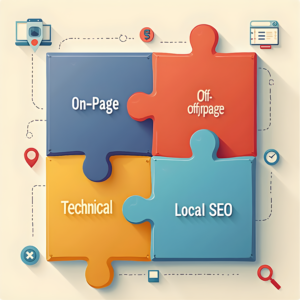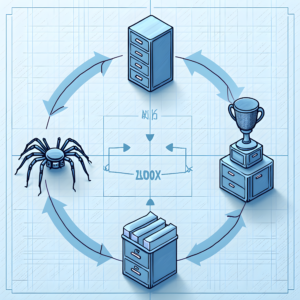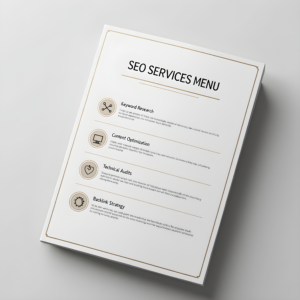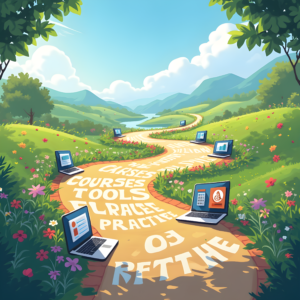If you’ve ever wondered why some websites pop up on Google’s first page while others are buried deep, the answer lies in Search Engine Optimization (SEO).
In the vast digital landscape, SEO is like a spotlight that shines on your website, helping it grab attention, increase traffic, and ultimately drive conversions.
So, let’s dive into what SEO really is and why it matters for anyone aiming to thrive online.
1. What is Search Engine Optimization (SEO)? A Simple Explanation

At its core, SEO is all about making your website easier for search engines to find, understand, and rank.
Think of search engines like Google or Bing as giant libraries, and SEO is how you ensure your book gets placed on the front shelf instead of gathering dust in the basement.
It involves tweaking your website, creating valuable content, and using the right keywords to signal to search engines that your page has the answers people are searching for.
But don’t get overwhelmed! You don’t have to be a tech wizard to grasp SEO.
It’s essentially a mix of art and science where the goal is simple—help search engines connect your website with the right audience. And when you get it right, the results are well worth the effort.
The Role of SEO in Driving Online Visibility
Imagine your website is a store on a bustling street. Without SEO, it’s like having your store hidden in a back alley with no signboard.
With SEO, your store is right on the main road, lit up with bright neon lights, attracting everyone walking by.
Search engines process billions of queries daily, and SEO ensures that your website appears when it matters most. Whether someone is searching for “best running shoes” or “how to bake a cake,” proper SEO strategies make sure your content aligns with their search intent.
This visibility is not just about showing up—it’s about showing up in the right place at the right time, giving you a competitive edge.
SEO Brings the Right Traffic to Your Website

Traffic is great, but not all traffic is created equal. This is where SEO becomes a game-changer.
By targeting the right keywords and optimizing your website, you attract visitors who are genuinely interested in what you offer.
These visitors are more likely to stay on your site, explore your content, and, most importantly, take action—like subscribing to your newsletter, making a purchase, or filling out a contact form.
For example, if you sell eco-friendly clothing, an optimized website can help you rank for phrases like “sustainable fashion brands” or “eco-friendly clothing near me.”
The result? People who care about your niche find you easily and are more likely to become loyal customers.
Conversions: The Ultimate Goal of SEO

Let’s be honest—visibility and traffic are fantastic, but what you really want is for people to take action. SEO helps with that, too!
When your website is optimized, it doesn’t just rank well; it also delivers a better experience for your visitors.
Things like fast loading times, mobile-friendly design, and easy navigation all contribute to turning casual visitors into paying customers.
Moreover, SEO allows you to build trust and credibility. Websites that appear on the first page of search results are often perceived as more reliable and authoritative.
And when you combine trust with a seamless user experience, the chances of conversions increase significantly.
That’s the magic of SEO—it’s like planting seeds that grow into strong, lasting customer relationships.
Why SEO Is a Must in Today’s Digital World
In today’s hyper-connected era, having a website without SEO is like having a phone without a signal—pretty useless, right?
SEO not only helps businesses compete but also ensures they stay relevant. As more people turn to search engines to find products, services, and answers, the importance of SEO continues to grow.
Even better, SEO is a long-term investment. Unlike paid ads that stop driving traffic as soon as you turn them off, SEO efforts can keep delivering results for months or even years.
It’s a sustainable way to grow your online presence and create a steady stream of opportunities.
2. Understanding the Different Types of SEO Specializations

When you hear the term Search Engine Optimization (SEO), it might sound like a one-size-fits-all solution, but SEO actually has many layers.
Each specialization plays a unique role in making your website a well-oiled machine that search engines love.
Let’s break down the four main types of SEO—On-page, Off-page, Technical SEO, and Local SEO—and explore how they come together to supercharge your website’s performance.
On-Page SEO: Crafting a Stellar User Experience
On-page SEO is like the interior design of your website. It’s all about what happens on your pages—content, keywords, and user experience.
This type of SEO focuses on creating high-quality, relevant content that aligns with what people are searching for.
It’s about sprinkling the right keywords naturally throughout your content so search engines know what your page is about.
But it’s not just about words. On-page SEO also involves optimizing elements like meta titles, descriptions, and headers. These act as your site’s first impression in search results.
For example, if someone searches for “best chocolate cake recipe,” your catchy meta title and keyword-rich description can entice them to click.
And let’s not forget images! Properly labeled images with alt text aren’t just good for accessibility; they help search engines understand your content better.
On-page SEO ensures everything on your website screams, “Hey, search engines, I’ve got what people are looking for!”
Off-Page SEO: Building Your Website’s Reputation

If on-page SEO is about sprucing up your house, off-page SEO is about making sure everyone in the neighborhood knows it’s the best house around.
Off-page SEO focuses on building your site’s authority and credibility across the internet, primarily through backlinks and social signals.
Backlinks are like votes of confidence from other websites. The more high-quality links you have pointing to your site, the more trustworthy search engines think you are.
But it’s not just about quantity—getting a shoutout from a reputable site like Forbes is way more valuable than a dozen links from random blogs.
Off-page SEO also includes your social media presence and brand mentions.
Engaging with your audience on platforms like Instagram, Facebook, and LinkedIn can indirectly boost your SEO by driving traffic and enhancing your online footprint. It’s like networking, but for your website!
Technical SEO: The Engine That Keeps Everything Running

Imagine having a beautiful car that doesn’t start—frustrating, right? That’s your website without technical SEO.
This type of SEO works behind the scenes to ensure your site is fast, secure, and easy for search engines to navigate.
Technical SEO covers things like improving your site’s speed (nobody likes a slow-loading page), ensuring mobile-friendliness, and setting up a clear site structure.
These factors not only make your site more appealing to search engines but also create a better experience for your visitors.
Ever heard of sitemaps and robots.txt? These are technical SEO’s secret weapons.
Sitemaps guide search engines through your site, while robots.txt tells them which pages to ignore. It’s like giving search engines a roadmap so they can easily find and rank your best content.
And let’s not forget HTTPS. A secure website is not just essential for protecting your users—it’s also a ranking factor for search engines.
Technical SEO is what keeps your site in tip-top shape, ensuring everything runs smoothly under the hood.
Local SEO: Standing Out in Your Community
If your business relies on local customers, Local SEO is your best friend. This specialization focuses on making your website shine in local search results.
Imagine running a bakery in Mumbai—Local SEO ensures you show up when someone searches for “best bakeries near me” or “fresh bread in Mumbai.”
One of the key components of Local SEO is optimizing your Google Business Profile. This is what helps your business appear in Google Maps and the local pack (you know, those three businesses at the top of search results).
A well-optimized profile includes accurate business details, glowing reviews, and attractive photos.
Local SEO also involves adding location-specific keywords to your content and building local backlinks. It’s all about letting search engines—and your community—know that you’re the go-to option in your area.
How These SEO Types Work Together
The beauty of SEO is that it’s not about choosing one specialization over another.
On-page SEO draws people in with great content, off-page SEO builds trust, technical SEO keeps everything running, and Local SEO helps you dominate your area.
Together, they form a powerful strategy to boost your website’s visibility and drive results.
By understanding these different types of SEO, you’re not just optimizing your site—you’re unlocking its full potential.
So, roll up your sleeves and dive into the wonderful world of Search Engine Optimization (SEO). Your website—and its visitors—will thank you for it!
3. How Search Engine Optimization (SEO) Works Behind the Scenes

Ever wondered what happens between typing a search query into Google and seeing a list of results? It’s all thanks to the incredible mechanics of Search Engine Optimization (SEO).
Beneath the surface, search engines are busy crawling, indexing, and ranking millions of web pages to deliver the best answers.
Let’s pull back the curtain and demystify how SEO works behind the scenes.
Crawling: The Search Engine’s Exploration Mission

Think of crawling as search engines’ way of exploring the internet, one link at a time.
Search engines use bots, often called “spiders,” to roam the web, discovering new and updated content. These bots start with a list of known pages and follow links from one page to another, like a digital treasure hunt.
Imagine you’ve just published a blog post about “The Best Coffee Recipes.”
A search engine’s bot might stumble upon your page through a link on a related site or your sitemap.
These bots “read” your content, analyzing everything from text and images to videos and metadata.
But here’s the catch: if your website has broken links or lacks a clear structure, bots might get stuck or miss important pages.
That’s why good website hygiene—like fixing broken links and creating a proper sitemap—is crucial for effective crawling. It’s like leaving breadcrumbs for the bots to follow!
Indexing: Filing Your Pages in the Digital Library
Once search engine bots finish crawling your site, they don’t stop there. The next step is indexing, where the real magic begins.
This is like the search engine’s filing system, where every discovered page is analyzed, categorized, and stored in a massive digital library.
During indexing, search engines look at your content’s keywords, headings, images, and structure to understand what your page is about.
For instance, if your blog post is all about coffee recipes, the search engine will tag it with keywords like “coffee,” “recipes,” and “best coffee drinks.”
Now here’s a pro tip: indexing loves clarity. When you use clear titles, concise headings, and well-written meta descriptions, you’re helping search engines understand your content better. If a page is hard to decipher or contains duplicate content, it might not even make it into the index. And if it’s not indexed, it can’t show up in search results—ouch!
Ranking: The Battle for the Top Spot
Ranking is where the action happens. This is the process that decides where your page appears on the search results page—whether it’s on the glorious first spot or buried on page ten.
Search engines use complex algorithms to determine rankings. These algorithms consider hundreds of factors, like keyword relevance, page speed, mobile-friendliness, backlinks, and user engagement.
It’s like a recipe with many ingredients, where each one plays a role in the final dish.
For example, let’s say your coffee recipe blog is fast, mobile-friendly, and packed with valuable content. If users spend time reading your page and sharing it, search engines take that as a sign your page is worth recommending.
Over time, your ranking improves, and more coffee lovers find your content.
But remember, rankings aren’t set in stone. Competitors can out-optimize you, search trends change, and algorithm updates happen.
That’s why consistent SEO efforts are key to maintaining your spot in the rankings.
Algorithms: The Brains Behind SEO

If crawling, indexing, and ranking are the steps, then algorithms are the brains that make it all work. These are sets of rules search engines use to evaluate and rank content.
Algorithms are like your favorite teacher—they reward high-quality, well-presented work and penalize anything that looks spammy or irrelevant.
For instance, Google’s algorithm checks if your site is secure (HTTPS), loads quickly, and provides a great user experience.
It also looks for helpful, unique content that matches search intent. If your blog delivers exactly what a user is looking for—like that perfect latte recipe—it gets a thumbs-up.
However, algorithms are ever-evolving. Updates like Google’s “Helpful Content” aim to improve how search engines understand and prioritize content.
Staying on top of these changes is part of mastering Search Engine Optimization (SEO).
Why Understanding These Mechanics Matters
By understanding how crawling, indexing, ranking, and algorithms work, you’re better equipped to create content that search engines—and users—love.
It’s not about gaming the system; it’s about making your website valuable, accessible, and user-friendly.
So, the next time you publish a blog or update your website, remember this behind-the-scenes process.
Each step—crawling, indexing, ranking, and algorithm evaluation—plays a critical role in getting your content in front of the right audience.
Master these mechanics, and you’ll not only understand what Search Engine Optimization (SEO) is but also how to harness its power for lasting success.
4. The Evolution of SEO: What It Means for Marketers Today

Search Engine Optimization (SEO) has come a long way since its early days of stuffing keywords into every nook and cranny. As search engines grew smarter, so did SEO strategies, evolving into a complex yet fascinating field.
Let’s take a walk through the history of SEO, explore its current trends, and see how it’s reshaping the way marketers connect with their audiences today.
The Early Days: When Keywords Ruled the World
Back in the 1990s and early 2000s, SEO was like the Wild West.
Marketers believed stuffing as many keywords as possible into a webpage was the golden ticket to the top of search results.
Pages were crammed with repetitive phrases, often to the point of absurdity—imagine reading “best coffee mugs” 20 times in two sentences!
During these early days, search engines like Yahoo! and AltaVista relied heavily on simple algorithms. They ranked pages based on keyword density and metadata, making it relatively easy to manipulate rankings.
But as you might guess, user experience took a backseat.
Then came Google, with its groundbreaking PageRank algorithm. Instead of just counting keywords, it considered the quality and quantity of backlinks.
This shifted the focus from spammy tactics to building authentic, high-value websites. It was the beginning of a more thoughtful era in Search Engine Optimization (SEO).
The Rise of Quality Content and User Intent

By the mid-2000s, search engines were learning to think like humans (or at least trying to).
Google introduced updates like Panda and Hummingbird, which penalized low-quality content and rewarded sites that matched user intent.
This marked a shift from keyword obsession to creating content that genuinely answered users’ questions.
Let’s say someone searched for “how to bake a chocolate cake.” Search engines now prioritized pages with detailed, easy-to-follow recipes over sites that simply repeated the phrase “bake chocolate cake.”
For marketers, this meant focusing on user-friendly layouts, engaging writing, and providing real value.
SEO was no longer about tricking search engines. It became about understanding your audience’s needs and creating content tailored to them.
Keywords still mattered, but context, relevance, and readability took center stage.
Mobile Optimization and the Era of Speed
With smartphones becoming an extension of our hands, the game changed again.
In 2015, Google announced mobile-friendliness as a ranking factor, making responsive design a must for SEO success. If your site wasn’t easy to navigate on a tiny screen, you were out of luck.
But it wasn’t just about looks—speed became equally important. Nobody wants to wait more than a few seconds for a page to load, and neither do search engines.
Tools like Google’s Core Web Vitals now measure page performance, rewarding sites that offer a fast, smooth experience.
For marketers, this evolution emphasized the importance of technical SEO. You had to ensure your site was mobile-friendly, fast, and secure—all while keeping content engaging and valuable.
AI and Voice Search: SEO in the Age of Technology

Fast forward to today, and SEO is entering a new frontier driven by artificial intelligence (AI) and voice search.
Google’s RankBrain, an AI algorithm, helps the search engine understand complex queries and deliver more accurate results. It’s like Google has learned to read between the lines.
Voice search has also shaken up the SEO landscape. With devices like Alexa and Siri, people now ask questions conversationally—like, “What’s the best pizza place near me?”
This means marketers must optimize for natural language and long-tail keywords to stay relevant.
Meanwhile, AI tools like ChatGPT are helping marketers generate ideas, analyze data, and create content that resonates with audiences.
These innovations are making SEO more dynamic than ever, but they also raise the bar for creating unique, high-quality content.
What This Evolution Means for You as a Marketer
So, what does all this mean for you?
In today’s world, SEO is about being strategic, authentic, and adaptable. You can’t just rely on old-school tactics like keyword stuffing or backlinks.
Instead, you need to embrace a holistic approach that combines quality content, technical expertise, and an understanding of emerging trends.
For instance, focusing on user experience is crucial. Make your site fast, mobile-friendly, and easy to navigate. Dive into analytics to understand what your audience loves, and use that insight to refine your strategy.
And don’t forget to keep an eye on the future. Trends like AI-driven personalization, visual search, and zero-click results are shaping the next phase of Search Engine Optimization (SEO).
Staying ahead of these changes can help you maintain your edge in an ever-evolving digital landscape.
The Future of SEO: A World of Endless Possibilities
As SEO continues to evolve, one thing remains clear: it’s about people.
Search engines are getting better at understanding what users want, and your job as a marketer is to meet those needs creatively and effectively.
Whether it’s optimizing for voice search, creating AI-enhanced content, or mastering mobile-first strategies, SEO is a journey of constant learning.
By embracing change and focusing on delivering value, you can ensure your website stays relevant, visible, and impactful.
So, the next time someone asks, “What is Search Engine Optimization (SEO)?” you can tell them it’s not just about rankings—it’s about connecting with your audience in smarter, more meaningful ways.
And that’s what makes it such an exciting field to explore!
5. SEO as a Service: What Agencies Offer to Businesses

Search Engine Optimization (SEO) can feel like a puzzle with too many pieces. This is where SEO agencies come to the rescue.
With their expertise and toolbox of services, they help businesses climb search engine rankings and connect with the right audience.
Let’s break down what digital marketing agencies bring to the table when it comes to SEO.
SEO Audits: Diagnosing Your Website’s Health
The first thing an SEO agency often does is conduct an audit of your website.
Think of it as a health check-up for your site. They dive into the details, looking at your site’s performance, structure, and content to find out what’s working and what’s holding you back.
For example, they’ll check if your pages are loading fast enough, if your site is mobile-friendly, and whether your URLs are clean and descriptive.
They’ll also hunt for broken links, duplicate content, and other issues that might be making search engines frown at your site.
The result? A detailed report highlighting areas for improvement. It’s like getting a roadmap that guides you toward a more search-engine-friendly website.
And the best part? You don’t have to guess where to start—an audit gives you clear priorities.
Keyword Research: Finding the Right Words to Rank For
When it comes to Search Engine Optimization (SEO), keywords are the backbone of your strategy.
SEO agencies specialize in finding the right keywords that your audience is searching for.
Using tools like Google Keyword Planner or SEMrush, they analyze search trends, competition levels, and potential traffic for different keywords.
But they don’t just stop at “high-volume” terms. Agencies dig deeper to find long-tail keywords—those specific phrases that people search for when they’re closer to making a purchase or decision.
For instance, if you run a bakery, ranking for “best chocolate cake recipe” might bring the right traffic to your blog.
On the other hand, “local bakery near me” could help you attract customers ready to visit your shop.
By targeting the right mix of keywords, agencies ensure your site captures the audience you want.
Content Optimization: Making Your Website Shine

Content is king, and SEO agencies act like the royal advisors.
They help you tweak your existing content and create new pieces that both readers and search engines adore.
This includes optimizing your headlines, adding relevant keywords naturally, and crafting meta descriptions that grab attention.
They’ll also check if your images have alt text and whether your internal linking strategy is strong enough to keep visitors exploring your site.
But it’s not just about stuffing keywords into paragraphs. Agencies focus on creating valuable, engaging content that answers users’ questions and keeps them coming back.
Whether it’s blog posts, product descriptions, or service pages, they ensure everything on your site is optimized for maximum visibility.
Technical SEO: Building a Strong Foundation
Behind every high-ranking website is solid technical SEO.
This is where agencies get their hands dirty with the backend of your site. They make sure your site’s code, structure, and performance meet the standards search engines love.
For example, they might improve your site’s loading speed, fix crawl errors, or implement schema markup to help search engines understand your content better.
They’ll also ensure your site is mobile-friendly because, let’s face it, nobody wants to pinch and zoom on their phone anymore.
Technical SEO might sound intimidating, but agencies handle the nitty-gritty so you don’t have to.
They’ll set up XML sitemaps, monitor your robots.txt file, and even check your server response times. It’s all about creating a smooth experience for both users and search engine bots.
Local SEO: Reaching Customers Nearby
If your business has a physical location or serves specific areas, local SEO is a game-changer. Agencies optimize your online presence so nearby customers can find you easily.
This often involves setting up and optimizing your Google My Business profile, ensuring your NAP (name, address, phone number) details are consistent across directories, and encouraging reviews.
Local SEO also includes targeting location-specific keywords, like “pizza delivery in Brooklyn” or “yoga classes near Sector 75, Noida.”
Agencies understand the unique challenges of local businesses and help you stand out in maps, local search results, and even voice search.
It’s all about connecting you with customers who are just around the corner.
Monitoring and Reporting: Keeping You in the Loop

The best SEO strategies evolve over time, and agencies ensure you stay on track. They monitor your site’s performance, track keyword rankings, and analyze traffic trends to fine-tune your strategy.
With regular reports, you’ll know exactly how your SEO efforts are paying off.
They’ll show you what’s working, where improvements are needed, and how close you are to achieving your goals.
Why SEO Agencies Are a Smart Investment
Partnering with an SEO agency saves you time, effort, and the headaches of figuring out SEO on your own.
They bring expertise, tools, and proven strategies to the table, helping your business thrive in the digital world.
So, the next time someone asks, “What is Search Engine Optimization (SEO)?” you can tell them it’s not just about getting ranked—it’s about building connections, solving problems, and growing your business with the right support. And that’s exactly what agencies are here to help you do!
6. Mastering the Basics: How to Learn SEO in 2025

So, after understanding what is Search Engine Optimization (SEO), now you want to master it? Great decision!
SEO is a powerful skill that can open doors to exciting opportunities, whether you’re looking to grow your business, land a high-paying job, or simply understand how search engines work.
But where do you even start? Don’t worry—we’ve got you covered with a beginner-friendly roadmap to learn SEO in 2025.
Step 1: Understand the Fundamentals of SEO
Before diving into tools and strategies, you need to grasp the basics.
Start by answering one crucial question: What is Search Engine Optimization (SEO)?
In simple terms, SEO is the art and science of improving a website’s visibility on search engines like Google.
To get started, you can explore beginner guides like Google’s Search Engine Optimization (SEO) Starter Guide. It’s free, easy to understand, and comes straight from the search engine giant itself.
You’ll learn about keywords, meta tags, backlinks, and more.
Another great resource is YouTube. Channels like Neil Patel and Ahrefs break down SEO concepts with visuals, making it easier to grasp tricky topics.
Step 2: Dive into Free Tools for SEO Practice

SEO might seem complicated, but free tools can make your learning process smoother. Here are some must-haves to get started:
- Google Keyword Planner: Use this tool to discover keywords people are searching for and understand their potential traffic.
- Google Analytics: This is your go-to for tracking website performance and user behavior.
- Google Search Console: It helps you monitor your site’s performance on Google and fix indexing issues.
Experimenting with these tools on a personal project or blog is the best way to learn.
If you don’t have a website, don’t worry—create a simple one using platforms like WordPress or Wix and start testing.
Step 3: Enroll in Beginner-Friendly SEO Courses
In 2025, the internet is brimming with courses, but which ones are worth your time?
- HubSpot Academy: HubSpot offers a free SEO course that’s perfect for beginners. It covers everything from on-page optimization to link-building basics.
- Coursera’s SEO Fundamentals by UC Davis: This affordable course provides a structured approach and teaches you the foundational elements of SEO.
- Semrush Academy: If you’re looking to explore advanced tools early on, Semrush offers free tutorials with certifications to boost your resume.
Pro tip: Look for courses with hands-on assignments. Practice is key when mastering SEO!
Step 4: Practice On-Page Optimization
On-page SEO is all about optimizing the content and structure of your website. It’s the perfect place for beginners to practice.
Start with simple tasks like:
- Writing clear and engaging meta descriptions.
- Using keywords naturally within your content.
- Creating descriptive and user-friendly URLs.
Take one piece of content—like a blog post or product page—and optimize it fully. Don’t forget to include alt text for images and add internal links to other pages on your site.
Step 5: Explore Off-Page SEO and Link Building
Off-page SEO might sound intimidating, but it’s simply about building your site’s authority and credibility.
Start with small steps, like:
- Creating profiles on social media and linking back to your website.
- Submitting your site to directories.
- Guest blogging on relevant websites to gain backlinks.
Remember, link-building is a marathon, not a sprint. Focus on building relationships with other site owners and delivering value through your content.
Step 6: Stay Updated with SEO Trends in 2025
The SEO world is constantly evolving. What worked in 2010 (hello, keyword stuffing) won’t fly today. Stay ahead of the curve by following SEO blogs and influencers.
Some of the best blogs to bookmark are:
- Moz Blog: Great for beginner and advanced topics.
- Search Engine Journal: Perfect for keeping up with industry news and updates.
- Backlinko: Offers actionable tips and case studies.
You can also join SEO communities on Reddit or LinkedIn to learn from others’ experiences and stay informed about the latest strategies.
Step 7: Measure, Analyze, and Improve

Learning What is Search Engine Optimization (SEO) is incomplete without understanding how to measure success.
As you apply what you’ve learned, track your progress using tools like Google Analytics and Search Console.
Ask yourself:
- Are you ranking higher for your target keywords?
- Is your site’s organic traffic increasing?
- Are visitors spending more time on your pages?
Based on your analysis, tweak your strategy to achieve better results. Remember, SEO is a long-term game, so patience is key.
Why SEO Is Worth Mastering
Learning SEO in 2025 doesn’t have to be overwhelming. By following this roadmap, you can build a solid foundation and set yourself up for success.
Whether you’re a business owner, a marketer, or just someone curious about the digital world, understanding SEO can make a big difference in how you connect with your audience.
So, what are you waiting for? Start your SEO journey today and discover how fun and rewarding it can be to master the art of ranking higher!
Conclusion: Elevate Your Digital Presence with SEO

Mastering the basics of SEO is no longer optional in today’s digital-first world—it’s essential.
By understanding what SEO is and why it matters, delving into its various specializations, and grasping the mechanics of how it works, you’ve taken the first step towards building a strong online presence.
As SEO continues to evolve, staying updated on the latest trends and adopting modern strategies will set you apart in the competitive digital landscape.
Whether you’re a marketer, business owner, or curious learner, there’s never been a better time to invest in SEO knowledge.
With the resources and insights shared here, you’re equipped to embark on your SEO journey and make a meaningful impact on your brand’s visibility and growth.
Remember, SEO isn’t just about search engines—it’s about connecting with your audience and creating value.
Start optimizing today, and watch your digital presence thrive!
Frequently Asked Questions
Do SEO Delivers Instant Results?
No it does not delivers instant results. SEO is a long-term game. It takes consistent effort over weeks or months to see measurable progress.
Do I Need Technical Skills for SEO?
Basic technical knowledge helps, but tools like Yoast SEO or All in One SEO make optimization beginner-friendly.
Do I Need to Pay for SEO Tools?
Many free tools like Google Analytics and Search Console provide excellent insights, but have to pay for premium tools to get advanced features.
How Do I Measure SEO Success?
Track metrics like organic traffic, bounce rate, and keyword rankings. These indicators show how well your strategy is working.





